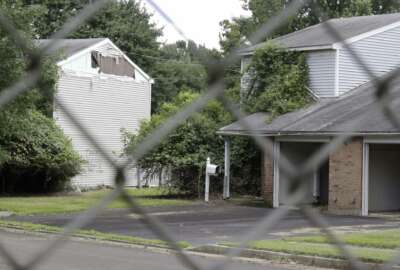
DoD improves oversight over private military housing, but with new costs to taxpayers
The military services have hired hundreds of new staff to ensure troops and their families have decent living conditions, but DoD says sustaining the improvements...
The Pentagon said it’s made major strides toward adding more accountability and oversight to the military’s privatized housing programs. But keeping housing companies honest will apparently come at a significant cost: DoD believes it will need to spend an additional $120 million per year to staff new programs to inspect and oversee those projects.
After the crisis in housing conditions on military bases became apparent to policymakers, Congress allocated nearly $200 million over the past two years to help boost DoD’s oversight over private housing providers. The goal of the increased oversight: to ensure that problems ranging from health-threatening mold infestations to routine maintenance issues were actually being addressed by the private firms who now control most of the military’s family housing, and to fix the most serious problems right away.
The military services are still assessing exactly how many staff they’ll need to conduct that oversight at each installation, but so far, they’ve hired about 500. DoD wants to turn those new staff into a permanent workforce of civilian employees who are trained to do the job and who will accumulate expertise over time.
“Those employees are doing activities that we, quite frankly, were not doing prior to 2018,” Paul Cramer, the deputy assistant secretary of Defense for installations told the House Appropriations Committee this week. “Those things had languished, and we had not put emphasis at the installation housing offices that we have today. They’re doing occupancy maintenance inspections … they’re being advocates for the families that may not received a quality move-in experience, or just can’t get issues resolved between themselves and the property manager. We’re doing increased advocacy, and we’re starting to see dividends, so continued funding at the same level is appropriate.”
And Cramer said even as DoD expands the government housing staff on each installation, the department is making clear that their primary job is to hold private housing providers accountable for delivering and maintaining homes that are up-to-standard.
Previously, the relationships between installation-level government employees and housing providers had gotten perhaps a bit too cozy, with government staff sharing office space with the employees of the same private firms they were ostensibly meant to oversee.
“We ended up with more of a friendship agreement, and that existed across-the-board,” he said. “And with friendship, they then tended to cover for one another. We’re now improving back to a partnership agreement. The offices have been separated out. In some cases, we have relocated the DoD employees into a separate building from the privatized housing entity. In other cases, we have created a firewall so there are at least separate doors. We’ve implemented those across the board.”
Going forward, the duties of the on-base government staff go well beyond serving as ombudsmen and resolving disputes between renters and landlords. They’re also charged with physically inspecting every housing unit at regular intervals.
That process began in the summer of 2019, when then-Defense Secretary Mark Esper ordered the military services to inspect every privatized housing unit. Once that process was done, the services decided it made sense to conduct those inspections every time a tenant moved out, and before a new family moved in.
Cramer said they’ve since adapted the process to visit tenants 30 days after their initial move-in, giving them time to discover deficiencies in their new housing.
“That way it’s not a situation where someone signs their lease and we tell them to call us if they have any issues. The military departments are proactive in going out to the houses, knocking on doors, and asking if there are any issues,” he said. “They’ve also implemented an annual inspection requirement. Some families may not let you in the house, but we’re going to the door to say, ‘Hey, it’s been a year since we last talked,’ and it’s a dialogue between the staff on the government side and the residents to ask whether there are issues with their housing or not.”
Meanwhile, the department is looking at ways to do more in-depth inspections of its privately-owned housing stock, so that government oversight staff aren’t just looking for obvious or cosmetic problems during those periodic checks.
At Fort Belvoir, Virginia, the Army has launched a pilot project to start examining all of its on-base homes with the same standards that private inspectors use outside the fenceline.
“The standard they’re using at Fort Belvoir is the code that exists in Fairfax County and in the Commonwealth of Virginia — we use it to go through and identify where there are maintenance deficiencies or structural issues with the home,” Cramer said. “We’re going to set a baseline, and the pilot at Belvoir will inform us as we go forward. The other thing we’ve done is train the new employees on what the expectations are so that we have consistency across all the military departments.”
As part of the 2020 Defense authorization bill, enacted in December 2019, Congress enacted a “bill of rights” for military housing tenants. But DoD has only fully implemented 15 of the 18 rights in that law so far.
The ones that remain unresolved are requirements for housing providers to give tenants a seven-year maintenance history for their homes, the ability for tenants to withhold rent when required maintenance isn’t done, and a new dispute resolution process.
Cramer said the new requirements are easy enough to implement for new housing projects. DoD can also impose them more-or-less unilaterally when a private provider wants to modify its current agreement with the government — for example, when it’s time to build new homes on a base.
But for existing agreements, enforcing the new bill of rights is difficult unless housing providers voluntarily consent to modify the terms of their contracts with the government, which typically last for 50 years. Even the oldest of those contracts still have 30 years before their expiration.
“It’s been a back-and-forth dialogue with the existing project companies to ask them to adopt them retroactively on their current projects,” Cramer said. “But we’ve gotten agreement from all but three companies to do that. I think we’ll eventually get them all on board. We’ve asked them to have those rights available for existing projects by the first of June.”
Copyright © 2025 Federal News Network. All rights reserved. This website is not intended for users located within the European Economic Area.
Jared Serbu is deputy editor of Federal News Network and reports on the Defense Department’s contracting, legislative, workforce and IT issues.
Follow @jserbuWFED





